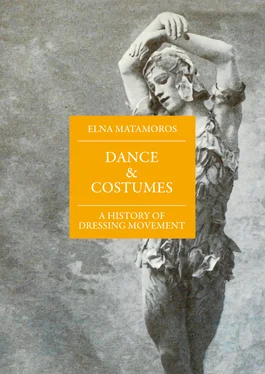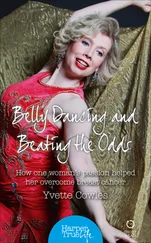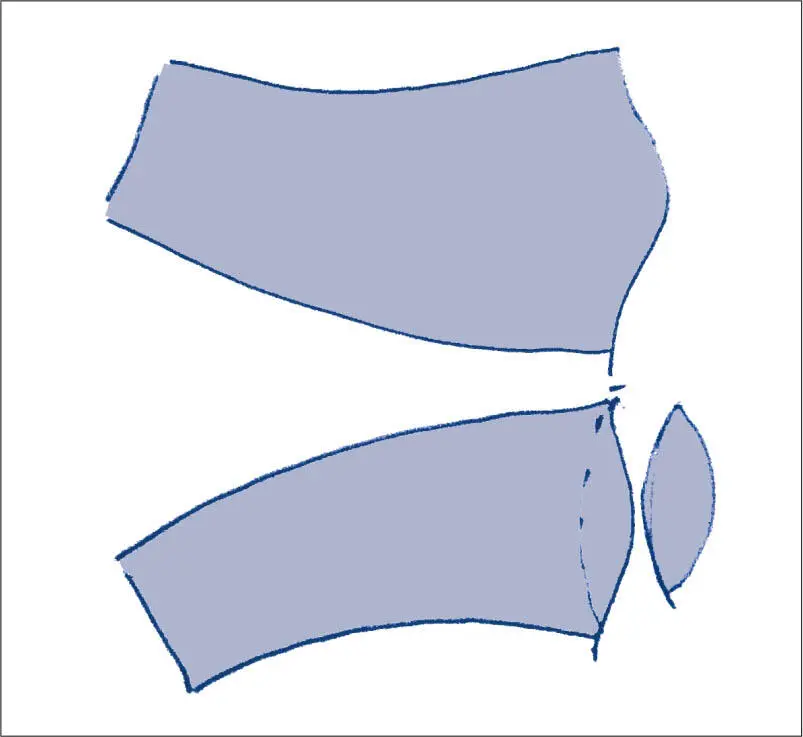
2.4 - Sleeve pattern. Drawing by Tatiana Noguinova, Mariinsky Theatre, 2009.
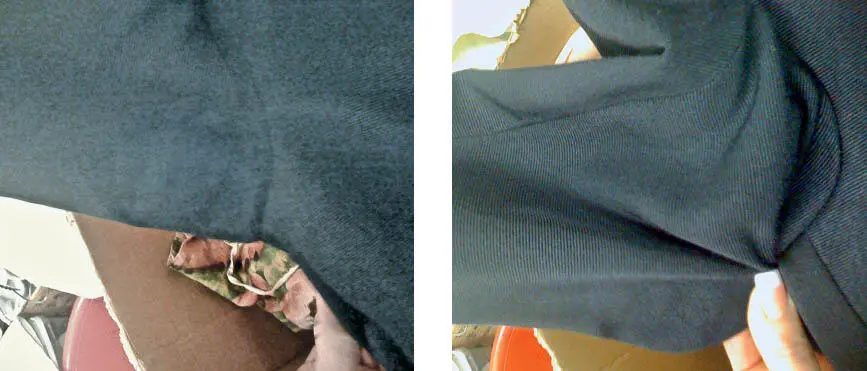
2.5 a & b - Detail of a male stage jacket. Costume-shop at the Mariinsky Theatre, St. Petersburg.
The sleeves of La Camargo’s dress, which we can see follow the usual design of those days –a tightly sewn down sleeve of three quarters length, probably with a false adorned cuff 50– barely reaching below the elbow, which is then decorated with spectacular ruffles following the fashion of the time. The sleeves could have two or three ruffles made with the dress’s own silk, and were known as the “classic rococo double or triple-sleeve ruffle.” 51This sleeve significantly beautifies the arms by visually diminishing the size of the hands, as demanded by the canons of feminine beauty of the 18 thcentury. No doubt the choreographer would have coached the dancer to move her hands with exquisite elegance. The headdress, so light that even Noverre would have approved it, 52would also not prevent her from performing fast turns, although there was no specific technique for using the head-spot for pirouettes at that time. 53Our dancer adorns her hair only by wearing a light floral decoration, which brings naturalness and joviality to the image. As a whole, only the skirt would prevent a higher rotation speed for performing turns on the ground or while jumping.
Curiously, despite having passed to posterity as a pioneer in having eliminated the heel from her dance shoes, and wearing ballet shoes similar to what we use today, 54in the images we have of La Camargo she is always depicted wearing high heels. In Lancret’s oil paintings, the dancer wears a pair of beautiful shoes, with presumably –if we look at them in detail– 6 centimetres-high heel and made, or lined, with a fabric similar to that of the dress: brocade silk with red ornaments on the tongue. The heel, leaning inwards, would force the dancer to keep her body weight closer on the metatarsals, far from the heels, which in a way would facilitate her quick raising sur la demi-pointe . A poorly trained body, or one not accustomed to standing on this heel, however, increased the risk of a sudden fall backwards, of even losing balance completely. What could be truly uncomfortable in street movements, presented some advantages to the dancer, something that both the performers and the ballet masters would know how to use.
La Camargo’s shoes, light in colour and closed by a beautiful red ribbon –in all the three paintings of her–, also have red heels; a detail that may go unnoticed but it is revealing due to its singularity if we think that it was a very rare feature at the time to chromatically separate the different parts of the footwear. In general, shoes used to be discreetly coloured, and only light or bright shades were used for special occasions and eye-catching dresses. 55This would undoubtedly be what La Camargo was looking for: her feet to stand out when she performed on stage. On the other hand, as Linda O’Keeffe points out, “red heels, a symbol of social prestige in 17 thand 18 thcentury Europe, were worn only by the privileged classes.” 56La Camargo, in addition, imposed her own style to the fashion of the moment, to the extent that, for the accessories and complements with its characteristics, the expression “à la Camargo” 57was coined. 58
Although in Lancret’s painting at the National Gallery in Washington, the dancer appears dancing with an unknown couple –at least their names have not reached us– and surrounded by a bucolic country landscape, it is surely a recreation of some of her scenic performances decorated by the pastoral settings that the painter used in most of his works. We find a whole theatrical staging perfectly studied to showcase the main artistic virtues of our dancer, and the choreographer –if not she herself– would take full advantage of it.
It is tempting to compare this image of La Camargo with a later one of Mademoiselle Anne Auretti. 59Anne Auretti danced in London between 1742 (Covent Garden) and 1765 (King’s Theatre), 60often accompanied by her sister Janneton. There is a print by Gérard Scotin, estimated to have been made approximately during these years, just a few decades later than Lancret’s La Camargo .
When comparing them, several things surprise us: the first and most important is that both dancers are portrayed in almost identical postures; it can almost be said that Auretti has imitated La Camargo in gesture, grace and even in clothing, bearing in mind that her portrait is later: the cut of the dress, the lower folds of the overskirt, the length of the pannier and the design of the sleeves are similar. Scotin has shaded the lower part of the dress, exactly under the gathered layers of the skirt, which makes us understand that the dancer wears a full dress, although slightly shorter than the inner petticoat, and thus reveals the fabric and adornments similar to those of the dress that covers it. The pannier, considerably larger than that of La Camargo, also shows the evolution of the fashion of the time, in which the volumes of women’s dresses were laterally enlarged, making it very difficult for women to move around even in their daily routines. We can suppose that in dancing, it would be so much more so, and that dancing as a couple would become quite complicated.
But apart from the size of the pannier, between the portrait of La Camargo and that of Mlle Auretti there are two other obvious differences, when it comes to the wardrobe. One is the design of the neckline of Auretti, much more open and daring 61as we will see in the prints; the other important difference can be seen when comparing the shoes of both dancers. Auretti’s heel is considerably shorter, would probably not reach 4cm in height, and the front of the shoe is lower, and is adorned with a buckle.
The fact that in a few decades the size of the pannier in dancers’ dresses –and with it the total weight of the dress– had increased, and the lowering of the necklines, could indicate that most of the jumped steps would have been removed from the choreographies. Perhaps we could consider this as a relapse in the technical gender equality on stage. To the contrary, however, the lowering of the heels and the front of the shoes would have facilitated the raising on demi pointe , since it would have also facilitated the flexion of the metatarsals. Although it is true that a lower heel requires more muscular strength and physical preparation to ascend to the relevé 62than a high heel –in which the body weight, as said before, is placed closer to the toes–, we should consider that it also facilitates the flexion of the knee needed to achieve a relevé . We can assume that the dances performed by Mlle Auretti had less proportion of jumping steps than La Camargo’s, but more rising sur la demi pointe and steps performed on her toes. Likewise, the fact that the pannier had enlarged, particularly towards the sides of the body, would prevent the dancer from lifting her legs behind the body –in the sagittal plane– because the legs would collide with the internal structure of the pannier. And so it is, at least in the images we have from both dancers: while La Camargo clearly shows a small arabesque , Auretti performs the movement of her left leg in front of her body; the eloquence of both images is unequivocal.
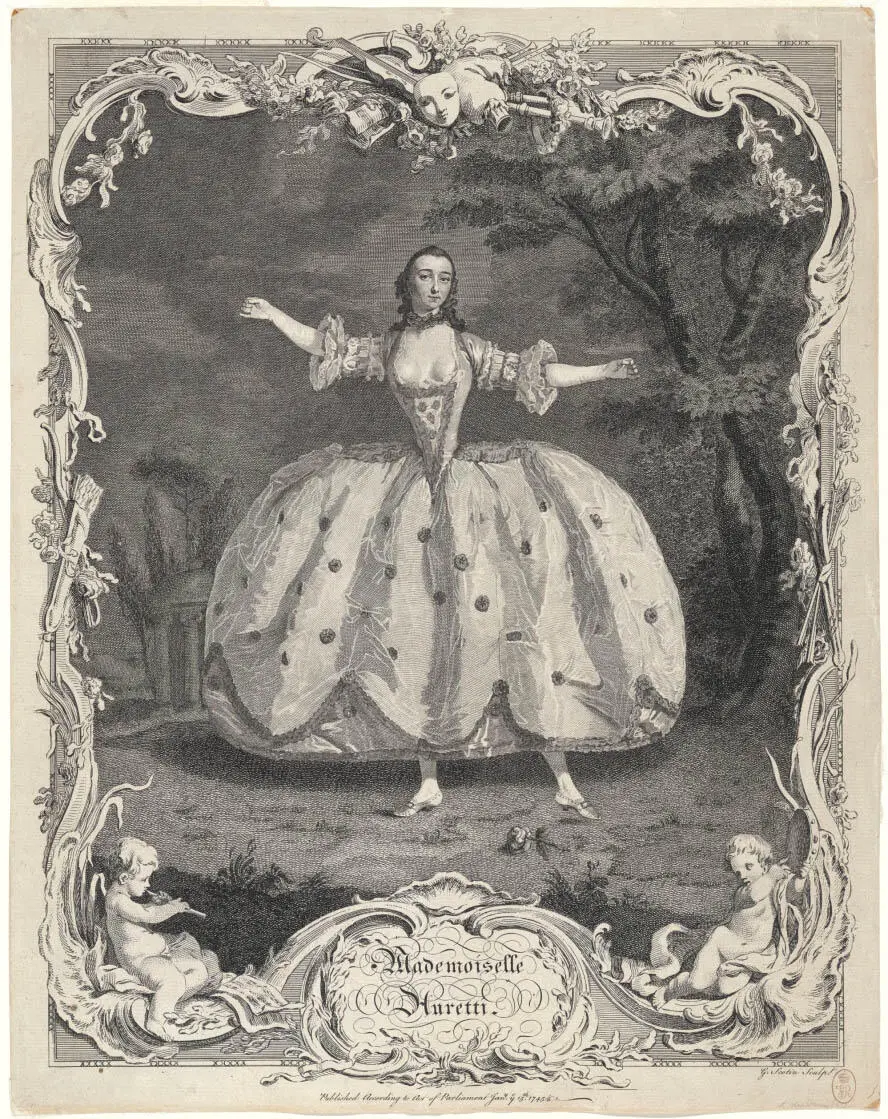
2.6 - Mademoiselle Auretti . Print by Louis Gérard Scotin, around 1745-55.
Читать дальше
